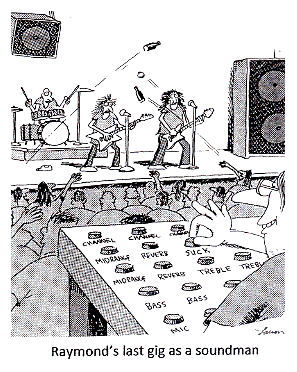LAUGHTON ELECTRONICS |
|
The Show Must Go On: even after the PA system goes kablooey |
|

|
I've enjoyed a good variety of experience in my stage and studio work, and it's not all been in the realm of technical support: I'm also a participant and a performer. In addition to hundreds of gigs as a professional musician, I also have some experience running sound for live bands. The following is a war story from the Murphy's-Law quagmire of live performance. It was less than an hour to show-time, and our setup was proceeding satisfactorily. It was a five-piece pop/rock band playing a wedding dance party, and I was the sound man. We'd rented a stereo console with built-in power amps, 200 or 300 watts a side; also some fairly beefy Mains with twin fifteens and a horn in each cabinet. It was quite a large room, but we weren't aiming for crushing decibels, and the gear seemed adequate for our needs. Adequate, that is, until the mixing console went kablooey. (Kablooey is a technical term.) It developed that the guitar player had recently done some “creative” wiring on the power cord of his amplifier. He had replaced the male three-prong plug, and without realizing it he ended up with a 115 VAC hot chassis on the amp! When I connected the usual line-out cable from his amp to the mixing console, the result was smoke from the latter. It didn't take long to diagnose and correct the mis-wiring of the guitar amp, but the console had no vital signs. We had a show to do, a dead PA, and no possible way to procure a replacement within the time available. The show must go onThe solution, humbly enough, was simply to use what we had that did work. We ended up playing the show with both big Mains cabinets and the vocalists' two monitor cabinets all powered by a single 120 watt mono Traynor board which we'd intended to use for monitor power alone. Running the mains & monitors simultaneously would ordinarily have been impossible, given the Traynor's 4-ohm minimum load specification. But instead of connecting all four cabinets in parallel I patched together a series-parallel configuration. There was no Rocket Science involved, just some quick thinking. Hacking the speaker cables let me wire the two 4-ohm main cabinets in series with one another, yielding an 8-ohm load. Similarly I connected the two 8-ohm monitor cabinets in series, yielding a 16-ohm load. Then I just connected both series strings to the Traynor's power amp section (in parallel), resulting in a net 5.3 ohm load: perfectly acceptable. The nice thing about this arrangement was that there was equal power sharing between the two mains, and likewise between the two monitors. Yet the monitors got one third of the amplifier power whereas the mains got two thirds. This was a favorable split, I felt, for the scanty allotment of watts we had to dispense. And how did we fare? The audience enjoyed themselves thoroughly, with no idea that anything had gone amiss! We weren't noticeably lacking in loudness. Substituting a mere 120 watts for upwards of 500 turned out to be an almost trivial issue -- something I understand well enough in terms of the ear's logarithmic perception of volume versus power, but all the same it's a disconcerting effect to see demonstrated! (As for the band, they remarked that the monitor mix was as good or better than any they'd ever had. But of course there was no “monitor mix” per se: the band just heard what the audience heard. This supports my opinion that separate mixes for mains and monitors are sometimes — perhaps very often — of no benefit, and indeed may be detrimental. When in doubt, K.I.S.S.) |
|
|
 |
|
